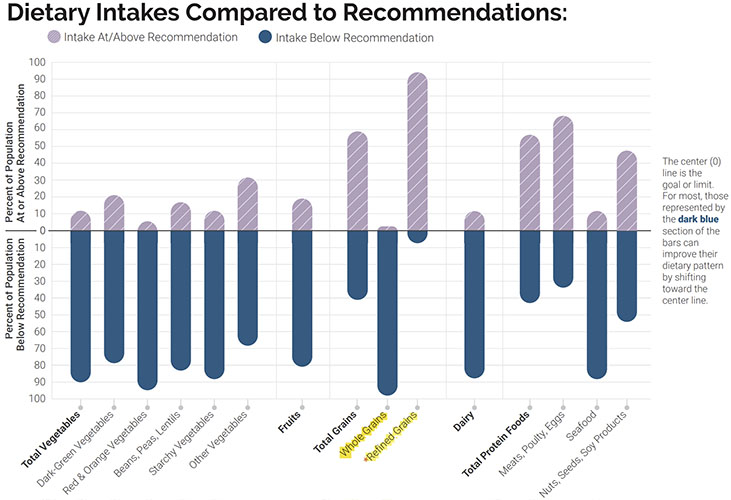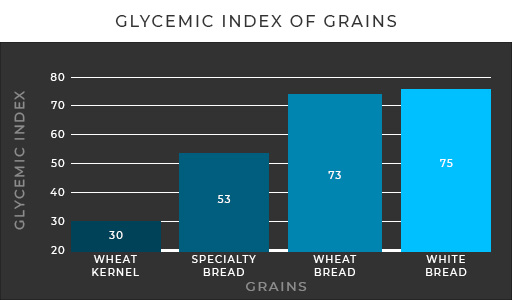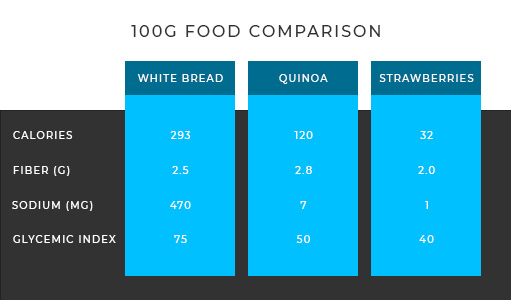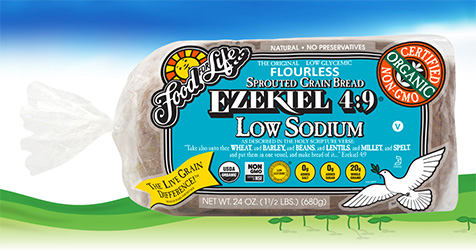I went from eating bread at every meal to largely avoiding it. It was a staple in my diet. It was the foundation of the USDA’s food pyramid. And it’s served with every meal from pizza and burgers to soups and salads. Is bread actually unhealthy? Why might you avoid it? And is there any bread I’d recommend? Well, let’s get into it!
Bread Consumption
According to the Dietary Guidelines for Americans, 98% of people do not consume enough whole grains [1]. That’s about everyone. The greatest source of whole grains in American’s diets is currently yeast bread. Bread is also our top source of fiber. Not surprisingly, only 3% of the population meets the fiber intake recommendation [2]. Despite bread being eaten with every meal, there’s one simple explanation for both low whole grain and fiber intake. Only 15% of people are eating whole grain bread [3]. Everyone else is eating white.

White bread is stripped of beneficial fiber and doesn’t count toward whole grain guidelines. It’s lower in key vitamins and minerals. And its nutrient sparsity aligns it with most desserts like cake, muffins, and doughnuts. But everyone knows white bread is bad. So why not switch to gluten-free versions? Because gluten isn’t the problem. Gluten-free bread often has worse nutritional composition, poor fiber content, and worsens gut microbiome diversity [4]. Avoiding gluten is only necessary for people with celiac’s disease or certain intolerances. So, is 100% whole grain bread the way to go?
Laced with Salt
Most bread is saturated with sodium. It’s one of if not the biggest contributor of salt in the American diet [5]. The Heart Association says eating less than 1,500mg per day is ideal for adults [6]. But 100g of white bread, or two medium slices, is 470mg. That’s 33% of your daily intake with only 15% of the daily calories. At that rate you’d consume more than double the Heart Associations recommendation. Which is what the average American consumes. And whole grain bread isn’t any better at around 445mg [5]. The added salt in bread is so bad that many are calling for policy changes. Unless the government steps in, this issue may be around for a while. Buying whole grain doesn’t fix it. But sodium isn’t even my biggest concern.
High Glycemic Index
You need flour to make bread. Flour is made by processing a whole grain like wheat until it’s broken down to a powder. You’ve gone from this slowly digested whole food to instantly absorbed dust. A food’s glycemic index is a metric that measures its digestion and absorption rate. Wheat, the whole kernel, has a glycemic index of 30 when cooked [7]. That’s low and slow. White bread is 75. Wheat bread isn’t much better at 73. There are specialty grain breads with lower indexes around 53 but nothing compares to eating the water-cooked whole grains [8]. White or wheat isn’t fixing the glycemic load.

Energy Density, Sugar, Oil, AGEs and more
This causes bread to be extremely energy dense. For example, 100g of bread is 300 calories. 100g of quinoa is only 120 calories. And 100g of strawberries is just 30 calories. Bread is ten times as energy dense as strawberries. Humans prefer energy dense foods which is why you’ll consistently crave fresh bread over strawberries [9]. You can eat more calories per bite. It’s why increases in bread consumption are associated with more weight gain and waist circumference gain [10].

There’s also the issue of glycation end products (AGE). Compounds like these generated during the baking and toasting process create pro-inflammatory and toxic compounds [11]. These are the same AGEs present on charred meat that increase cancer risk. Now there may not be enough AGEs in bread to cause harm but it’s worth considering. I like to reduce my toxin exposure. And then there’s the addition of sugar, oil, and various preservatives added to bread. None of which are found by eating the water-cooked whole grain.
Healthy Alternative
With all that you might think I never eat bread. But I do! As someone who sometimes struggles to consume enough calories each day, usually when I don’t have food prepped, bread is a convenient option. A peanut butter sandwich is filling and takes seconds to make. I prefer the high energy density at times. But I still don’t like the sodium, glycemic index, sugar, salt, and other additives.

That’s why the only bread I buy is Ezekiel 4:9, low sodium, sprouted grain bread. This bread is grainy. Because it’s flourless. You can tell by eating it that the grain wasn’t processed nearly as fine. Its why it has a glycemic index of 36. There’s no added salt, sugar, or oil. And it’s made with multiple sprouted grains and legumes like barley, millet, lentils, and soybeans. This increases its nutrient diversity. You can find this in the frozen aisle of many supermarkets. And while I prefer the water-cooked whole grains if I have time to make them, the Ezekiel bread is the healthiest alternative I’ve found.
Final Thoughts
Bread will forever be served in every restaurant at every meal. Its energy density makes it highly palatable. It’s difficult to pass up. But its staggering glycemic index, sodium content, added sugars, oils, and toxic AGEs are what I want to avoid. Ideally, we should be getting our whole grains from water-boiled sources like oat, millet, and spelt. Its why I recommend steel-cut oats for breakfast every morning. One serving of that is packed with fiber and nutrients. But when bread is preferred, I recommend Ezekiel 4:9, low sodium, sprouted grain bread. It’s the best alternative I’ve found. And it’s my latest habit for health excellence.

